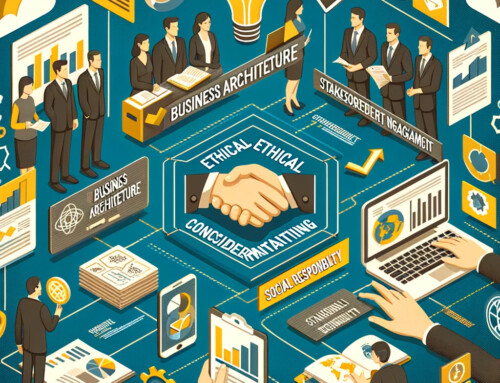
TOGAF, or The Open Group Architecture Framework, is a topic that can polarize practitioners in enterprise architecture. It is a methodology and set of tools to help organizations design, evaluate, and implement technology strategies and architectures effectively. Like any framework, its effectiveness can depend on the context in which it’s applied, including the nature of the organization, the complexity of its technology landscape, and the skills of its architects. Here is a balanced perspective on what TOGAF is and what it is not.
What TOGAF is:
- A comprehensive framework: TOGAF covers all aspects of enterprise architecture, including business, data, application, and technology architecture. It provides a holistic view of an enterprise’s strategy, processes, information, and IT assets, aiming to align these areas with its objectives.
- Methodology-oriented: The ADM (Architecture Development Method) is the core of TOGAF. It is a method for developing an enterprise architecture, providing a set of phases that guide the process from vision to maintaining an architecture.
- A source of best practices: TOGAF is filled with best practices compiled over decades from numerous enterprise architecture projects. It provides a common language and reference models architects can use to communicate more effectively.
- Flexible and customizable: TOGAF is intended to be adapted to fit the needs of the organization using it. It is not a one-size-fits-all solution, but rather a toolkit that can be tailored to suit various needs and contexts.
- Vendor-neutral: TOGAF is not tied to any specific vendor or technology. It is designed to provide a neutral, universally applicable approach to designing and implementing enterprise architecture.
What TOGAF is not:
- A silver bullet: TOGAF is not a magic solution to all enterprise architecture challenges. Success depends on a wide range of factors, including the skills and expertise of the team using it, the involvement of stakeholders, and the nature of the organization and its technology landscape.
- A detailed implementation guide: While TOGAF provides a high-level methodology and process, it does not provide detailed, step-by-step instructions for implementation. Organizations must interpret and adapt the framework to their unique circumstances.
- Quick and simple: Implementing TOGAF can be complex and time-consuming. It requires significant upfront investment in time and resources to adapt the framework to the organization’s needs and train people to use it effectively.
- Easily measurable: TOGAF does not provide specific metrics for evaluating the success of an enterprise architecture project. Measuring success can be challenging and is often subjective, depending on the specific goals and objectives of the project.
- Necessarily appropriate for all contexts: While TOGAF is designed to be adaptable, it may not be the best fit for all organizations or projects. Smaller organizations or those with less complex technology landscapes may find the framework too heavy and cumbersome.
In conclusion, TOGAF has its strengths and weaknesses. It is a comprehensive, flexible, and vendor-neutral framework that provides a useful starting point for many enterprise architecture projects. However, it is not a panacea and may not fit every organization or project best. It requires significant time, resources, and expertise to implement effectively, and its success depends on a wide range of factors that go beyond the framework itself. As such, organizations should consider their unique needs and circumstances when deciding whether to adopt TOGAF.
Five Dos and Don’ts on How to Leverage TOGAF
Five Dos:
- Do customize TOGAF to your organization’s needs: TOGAF is designed to be tailored according to your organization’s specific context. The framework is not intended to be implemented verbatim but should be adapted to fit your unique business requirements, culture, and technological context.
- Do invest in training: TOGAF is a comprehensive and intricate framework that can be complex to understand and apply. Investing in quality training for your team to ensure they have a firm understanding of TOGAF and can effectively utilize it is crucial.
- Do establish clear governance: Governance is key to successful TOGAF implementation. Clear decision-making processes and roles should be defined to maintain consistency, manage change, and ensure alignment with business objectives.
- Do involve stakeholders: Enterprise architecture is most effective when it is aligned with the needs of stakeholders. Engage stakeholders throughout the process, from defining the vision to validating the architecture.
- Do use it as a communication tool: TOGAF provides a common language for enterprise architecture, making it easier for stakeholders to understand and engage with the architecture. Use it to facilitate discussions about your technology strategy and architecture.
Five Don’ts:
- Don’t expect quick results: Implementing TOGAF can be a time-consuming process. It involves thorough planning, analysis, and design. Instead, don’t expect immediate results but view TOGAF implementation as a long-term strategic initiative.
- Don’t ignore the human factor: The success of a TOGAF initiative doesn’t solely depend on technical factors. It also hinges on elements like communication, change management, and the organization’s culture. Make sure to take these factors into account in your TOGAF initiative.
- Don’t try to do everything at once: It can be tempting to tackle all architectural domains (business, data, applications, technology) simultaneously. However, this approach can be overwhelming. Instead, focus on the most critical areas first and gradually expand your scope.
- Don’t use TOGAF just because others are using it: Just because TOGAF is popular doesn’t mean it is the right fit for your organization. Consider your specific needs, the complexity of your technology landscape, and your team’s skills when deciding whether to use TOGAF.
- Don’t underestimate the importance of leadership support: Senior leadership support is crucial for the success of a TOGAF initiative. Without it, you may struggle to secure the necessary resources or manage organizational change effectively.
Implementing TOGAF, like any enterprise initiative, requires careful planning, good communication, and strong governance. By following these guidelines, organizations can increase their chances of success with TOGAF.


